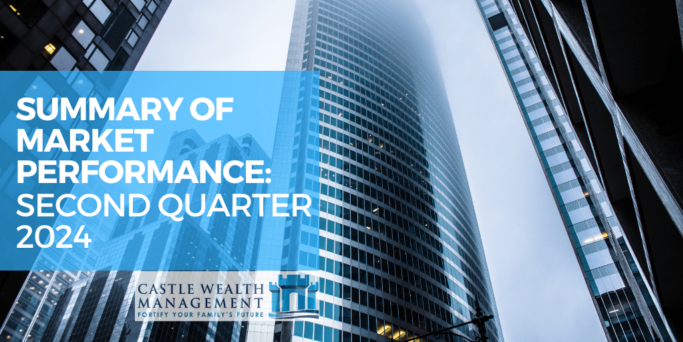U.S. Equity Investment Environment
After a challenging start, U.S. equity markets continued their upward trajectory, despite concerns about persistent inflation and reduced expectations for the Federal Reserve to cut interest rates. In June, the unemployment rate rose to 4.1%, its highest level since October 2021, yet it remains historically low. The S&P 500 recorded a 4.3% second quarter gain, bringing its year-to-date increase to 15.3%, setting a series of record-closing highs. In contrast, the Nasdaq-100 advanced 8.0%, while the Dow Jones Industrial Average retreated 1.3% over the prior three months, highlighting the dispersion of returns across sectors. Information Technology was the top-performing sector with a 13.8% gain for the quarter, led by Microsoft Corp., Apple Inc., and Nvidia Corp., which have battled for most valuable public company by market capitalization, each surpassing the $3 trillion dollar mark. Materials saw the largest decline this past quarter, lower by 4.5%, followed by industrials, with a 2.9% drop. Small- and mid-capitalization issues continued to lag with the S&P SmallCap 600 down 3.1% and the S&P MidCap 400 falling 3.5%. The gap in valuation between small-cap and large-cap stocks has widened to levels not seen in decades. Growth stocks, particularly those associated with artificial intelligence continue to outperform value-oriented issues across all market capitalizations.
International Equity Environment
Foreign developed markets lagged the U.S. with the MSCI EAFE Index declining 0.4% for the quarter. The European Central Bank cut interest rates a quarter point to 4.25% in June as inflation moderated. European shares declined because of reduced expectations for significant interest rate cuts and uncertainty stemming from the European parliamentary election outcomes, prompting President Macron of France to announce a snap election. UK markets rose 3.7% in the second quarter as inflation reached its lowest level since July 2021. Japanese stocks fell 4.3% in the second quarter as the Japanese Yen hit its lowest level against the US dollar in 38 years. Emerging markets outperformed as the MSCI Emerging Markets Index gained 5.0% in Q2. China’s market rebounded this quarter, up 7.1% but still only up 4.7% year to date. Chinese policymakers increased the pace of monetary, fiscal, and regulatory easing measures to support growth, yet it remains uncertain whether these efforts will translate into a full-scale economic resurgence. Shares in India reached record highs, surging 10.2% this quarter, driven by continued positive investor sentiment and gains in the media and banking sectors.
Fixed Income Environment
The Bloomberg U.S. Aggregate Bond Index rallied modestly, 0.1% in Q2 but was still down 0.7% for 2024. The June Fed meeting delivered a relatively hawkish tone, keeping interest rates unchanged as expected. Hopes of a soft landing for the economy grew as the quarter progressed despite the latest dot plot indicating just one rate cut for 2024, a decrease from three cuts previously anticipated. The 10-year Treasury yield finished the quarter at 4.36%, a slight increase from 4.33% last quarter. The yield spread between the two-year and ten-year Treasuries remains inverted at 35 basis points, persisting since the summer of 2022 without signs of a recession. Long-dated Treasury bonds fell 1.8% this quarter and the Bloomberg Municipal Bond Index declined 0.02%.High-yield bonds enjoyed another positive quarter, up 1.1%, despite historically tight credit spreads.
Commodities Environment
In the second quarter, the S&P GSCI Index advanced modestly, up 0.65%. Industrial and precious metals were standout performers within the index, while agriculture was the weakest. Gold continued its strong performance, rising 4.9% during the quarter, while Silver delivered an impressive 17.8% return driven by the rise in global industrial demand. Energy experienced a modest uptick of 0.7%, supported in part by an 18.0% rally in natural gas prices.

